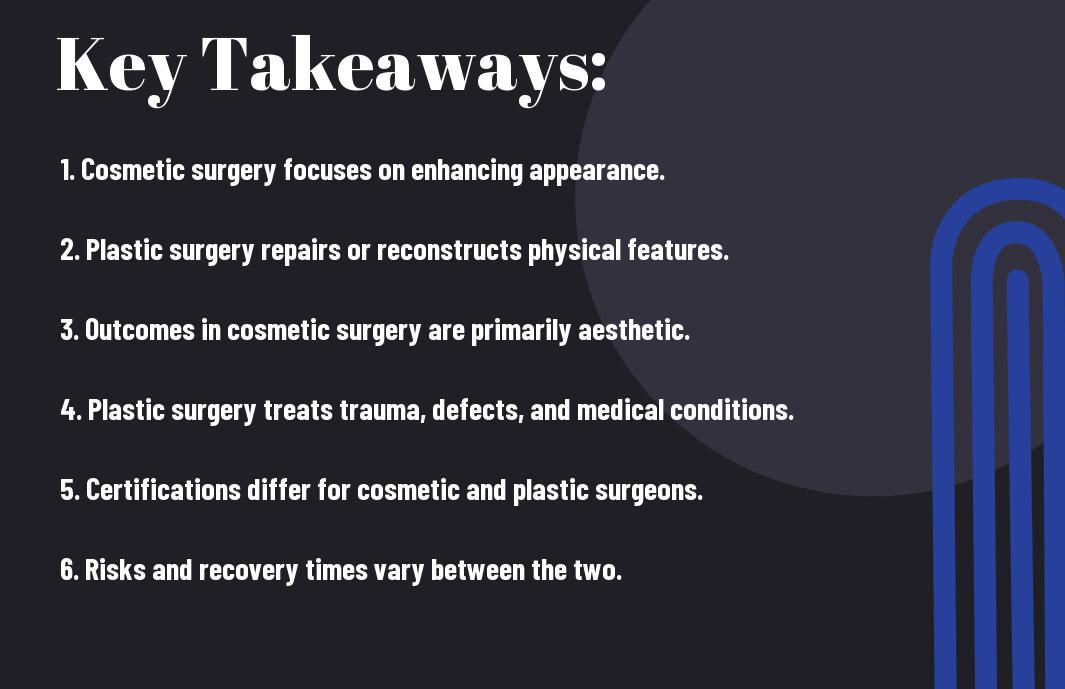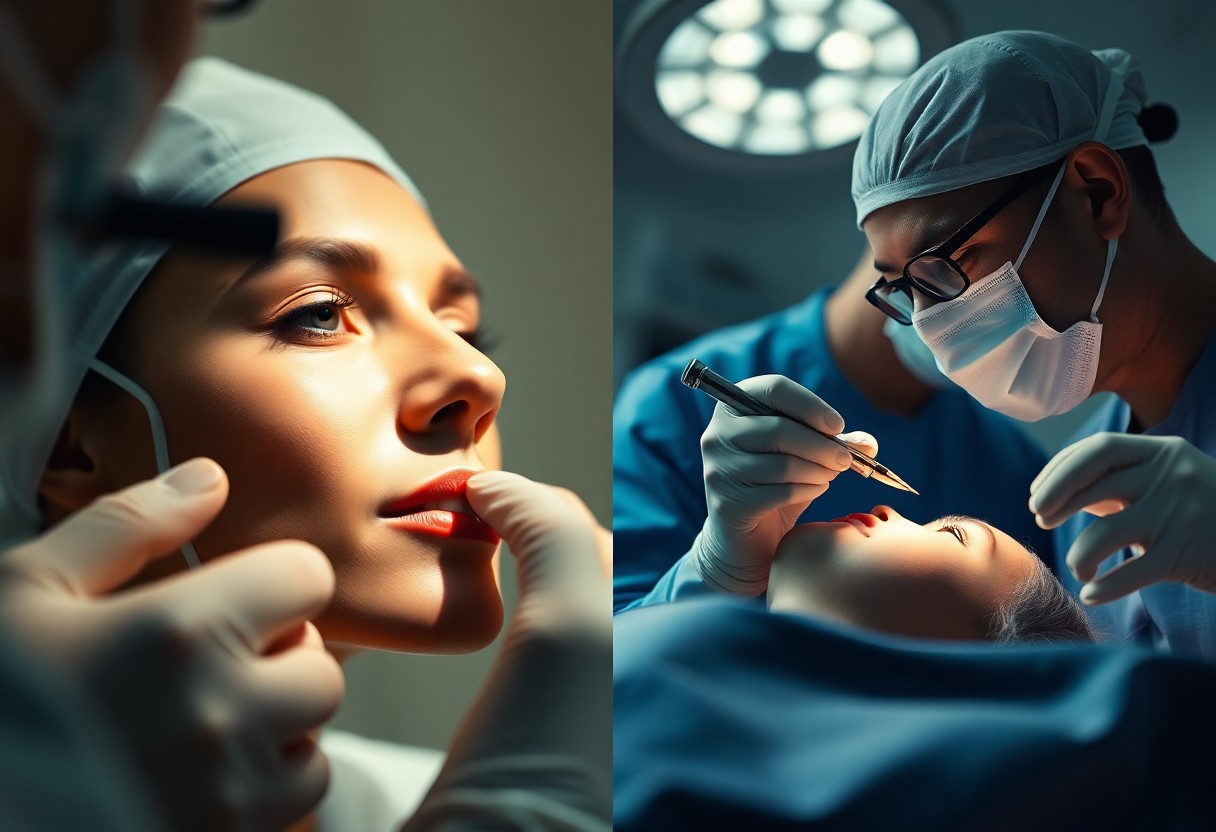Most people often confuse cosmetic surgery with plastic surgery, believing they are the same. However, these two fields serve different purposes and have distinct goals. In this informative guide, you will learn about the differences in procedures, motivations, and outcomes between cosmetic and plastic surgery, helping you understand which option may be best suited for your needs. By the end, you will have a clearer perspective, enabling you to make informed decisions about your surgical options.

Definition of Cosmetic Surgery
To understand cosmetic surgery, you should know that it primarily focuses on enhancing appearance through surgical and non-surgical techniques. This branch of medicine is dedicated to improving aesthetic features, often addressing concerns related to facial symmetry, body contours, and skin texture. Cosmetic surgery is elective, meaning it seeks to improve your self-esteem and confidence rather than address any medical issues.
Overview and Purpose
Behind cosmetic surgery lies the desire for self-improvement and personal satisfaction. It aims to help you achieve your ideal look, providing you the freedom to enhance your features based on your individual preferences. Whether for balanced proportions or rejuvenated skin, the goal is to help you feel comfortable and confident in your own skin.
Common Procedures
Across the field of cosmetic surgery, various procedures cater to different needs, with some of the most popular options including breast augmentation, liposuction, rhinoplasty, and facelifts. Each of these procedures is designed to enhance a specific area of your body, allowing you to target particular concerns that may affect your self-image.
At the core of cosmetic surgery, you can explore a variety of popular procedures tailored to your desires. Breast augmentation enhances breast size and shape, while liposuction targets stubborn fat deposits for a more contoured appearance. Rhinoplasty reshapes the nose for better harmony with facial features, and facelifts help reduce signs of aging. Each of these procedures serves to improve your overall aesthetic, empowering you to make choices that align with your vision of beauty.
Definition of Plastic Surgery
You might be surprised to learn that plastic surgery is a specialized branch of medicine that focuses on the repair, reconstruction, and alteration of the human body. It encompasses a wide range of surgical procedures aimed at restoring function to damaged body parts and improving individual aesthetics. Unlike cosmetic surgery, which is primarily focused on enhancing appearance, plastic surgery often addresses significant structural issues resulting from trauma, congenital defects, or medical conditions.
Overview and Purpose
The primary purpose of plastic surgery is to restore form and function to the body, addressing problems that may have originated from injury, disease, or congenital anomalies. This branch of surgery not only enhances your appearance but also improves your overall quality of life by increasing your physical capability and emotional well-being.
Common Procedures
By understanding the common procedures associated with plastic surgery, you can better appreciate its varied applications. Some common surgeries include breast reconstruction after mastectomy, cleft lip and palate repair, and skin grafting for burn victims. These procedures not only focus on aesthetics but also play a critical role in helping individuals regain functionality.
Another point to consider is that many plastic surgeries are deemed medically necessary, especially when they aim to correct deformities or restore function. For example, a person who has suffered a severe burn may require skin grafts to close wounds and restore the appearance of their skin, while reconstructive surgery can significantly improve the quality of life for individuals with congenital defects. Thus, plastic surgery serves as a vital medical field that addresses both functional and aesthetic concerns, making significant impacts on individuals’ lives.
Key Differences Between Cosmetic and Plastic Surgery
Your understanding of the differences between cosmetic and plastic surgery is imperative for making informed decisions about your health and aesthetic goals. While both fields aim to enhance appearance, cosmetic surgery focuses primarily on improving features and aesthetics, whereas plastic surgery often reconstructs and restores function after trauma or surgery. Understanding these distinctions will help you choose the right approach depending on your needs.
Goals and Outcomes
About cosmetic surgery, the primary goal is to enhance your appearance for aesthetic reasons, resulting in improved self-esteem and confidence. In contrast, the goal of plastic surgery may involve restoring function and rebuilding body parts after accidents, tumors, or congenital issues, which can lead to both functional and aesthetic improvements.
Training and Qualifications
Before considering any surgical procedure, it’s important to understand the training and qualifications of the professionals involved. Cosmetic surgeons typically have training in aesthetic procedures, while plastic surgeons undergo rigorous training in reconstructive techniques, ensuring they can handle complex medical scenarios and restore both function and form.
The level of training and qualifications varies significantly between cosmetic and plastic surgeons. Cosmetic surgeons often complete specialized training focused solely on aesthetic procedures, whereas plastic surgeons generally undergo extensive residency programs in plastic surgery, emphasizing reconstructive methods. This distinction plays a vital role in the type of care and expertise you should expect, so choosing a surgeon with the appropriate credentials is paramount for your safety and desired results.

Patient Considerations
All individuals contemplating cosmetic or plastic surgery should carefully evaluate their personal motivations, potential risks, and expected outcomes. Understanding these aspects helps you make informed decisions that align with your goals and values. It’s crucial to consider how the procedure may affect your physical and emotional well-being, as well as how it fits within your lifestyle and personal circumstances.
Motivations for Surgery
On your journey toward surgery, your motivations can significantly influence your decision. Many undergo these procedures to enhance their appearance, boost self-confidence, or correct physical imperfections. It’s important to assess whether your reasons stem from personal desires or external pressures, as understanding the underlying motivation can lead to more fulfilling outcomes.
Risks and Benefits
Motivations for surgery should be weighed against the possible risks and benefits involved. While surgeries can transform your appearance and improve your self-esteem, they can also come with complications, such as infection or dissatisfaction with the results. Assessing these factors helps you create realistic expectations and prioritize your health and safety throughout the process.
Due to the potential complications associated with surgical procedures, it’s vital to consult with qualified professionals and conduct thorough research. By weighing the expected aesthetic results against the likelihood of complications, you can make a more balanced decision. Understanding both the short-term and long-term implications of surgery will ensure you make choices that are beneficial for your overall well-being.
Recovery and Results
Now that you’ve chosen the procedure that best suits your needs, understanding the recovery and results phase is crucial. Recovery experiences can differ significantly between cosmetic and plastic surgery. While both involve some downtime, the extent of recovery may vary based on the complexity of the procedure and your body’s response, ultimately influencing your satisfaction with the results.
Recovery Processes
With each type of surgery, recovery processes will differ. Cosmetic surgery may involve less invasive techniques, possibly leading to quicker healing times. On the other hand, plastic surgery often necessitates a more extended recuperation period, as the procedures tend to be more extensive, requiring careful management to ensure optimal healing.
Expected Outcomes
Against the backdrop of your chosen procedure, understanding expected outcomes is vital. Cosmetic surgery generally aims at enhancing specific features, providing subtle changes that may help rejuvenate your appearance, while plastic surgery focuses on structural alterations, often resulting in more dramatic transformations.
This can significantly impact your self-esteem and body image. It’s important to have realistic expectations. Most cosmetic procedures will provide immediate results, but full healing may take several weeks. Plastic surgery often leads to more noticeable and lasting changes, though the recovery might involve swelling and bruising, influencing your appearance initially. Consulting with your surgeon regarding what to expect can help you navigate through both the recovery process and the anticipated results for your body and confidence.
Frequently Asked Questions
Once again, you may have questions regarding the distinctions between cosmetic and plastic surgery. These inquiries often arise from a lack of clear understanding about the disciplines and procedures involved. It’s necessary to seek information from reliable sources, as misinformation can lead to confusion and unrealistic expectations. Additionally, qualified professionals can guide you in making informed decisions that align with your aesthetic needs and goals.
Myths and Misconceptions
Against popular belief, cosmetic and plastic surgery are not synonymous, and many myths cloud their differences. Understanding the facts is vital for making educated choices regarding your health and appearance. You might hear exaggerated claims about procedures or outcomes, which can foster unrealistic expectations. Differentiating between truth and myth is necessary for your journey.
Clarifying Terminology
Behind the terms ‘cosmetic’ and ‘plastic’ surgery lies a complex landscape that often confuses individuals seeking enhancement or reconstruction. Understanding these definitions helps you better navigate your options and find the right surgeon for your needs.
Considering the terminology can empower you in your journey. Cosmetic surgery focuses primarily on enhancing your appearance, while plastic surgery encompasses a broader range of reconstructive procedures to restore function and form. Knowing these distinctions can significantly impact your decision-making process, as you evaluate which type of procedure aligns with your personal goals and medical needs. Be sure to communicate openly with your surgeon about these terms to ensure clarity and confidence throughout your experience.
Conclusion
With this in mind, understanding the difference between cosmetic and plastic surgery allows you to make informed decisions about your health and appearance. Cosmetic surgery focuses on enhancing your beauty for aesthetic purposes, while plastic surgery often addresses reconstructive needs stemming from trauma or medical conditions. By recognizing these distinctions, you can better assess your options and choose the right specialist to meet your individual needs and goals.

